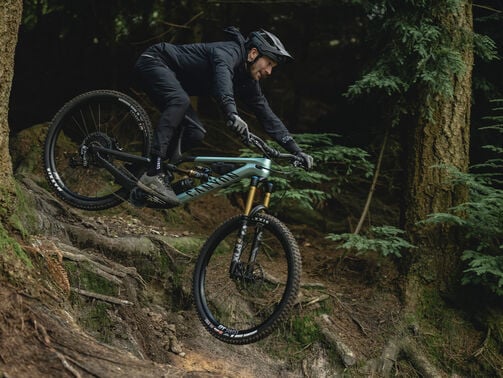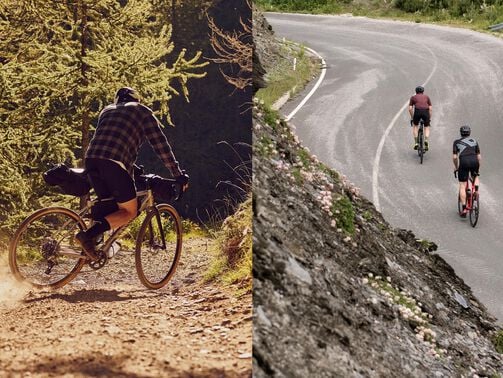Gravel bike geometry explained: Find the right fit for your ride.
Learn how to decipher geometry charts to find your perfect gravel bike. This guide will talk you through the key numbers to help you decide what type of gravel bike would suit you best.


People love gravel riding for many different reasons. For some, it is epic, multiple-day adventures or hardcore racing, for others it is a nice spin around the local woods or nipping to the shops, there is no right or wrong answer. All that matters is what you enjoy, and understanding the gravel bike geometry numbers can help you find the right bike for you.
Because gravel riding is so many things to so many people, gravel bikes can have significant differences depending on the rider they are designed for. Using the geometry chart is one of the best ways to understand how different they will feel. The small, but significant changes between bikes may seem like minor details, but they define not only whether a bike will fit you, but how it will feel out riding.
We make two gravel bikes: the Grail and the Grizl. They are designed for slightly different riders - the Grail built for speed, while the Grizl is more about exploration. If you are not sure which would suit you best, we wrote this short guide to help you choose between them.
컨텐츠
A brief history of gravel riding
The roots of gravel riding are as old as cycling itself. As the bicycle became popular in the late Nineteenth Century, asphalt roads were a rarity until the mass adoption of the automobile more than half a century later. From the Rough Stuff Fellowship taking unsuitable bikes into wild places in the 1950s to Tour de France contenders scaling mountains on gravel tracks, the history of cycling is filled with stories of riders heading far from the beaten path.
Modern gravel riding has deep roots in the USA. In a country with 1.4 million miles of unpaved roads, cyclists in rural areas naturally gravitated to these farm tracks and mountain roads. Eventually racing started, and the sport we know as gravel racing began with the Dirty Kanza in 2006. Winding through Flint Hills of Kansas, it started with just 34 riders tackling the 200-mile route. By 2022 that number had swelled to 4,000 participants, marking gravel as a major cycling discipline.
You may feel our roads are becoming busier and busier, and drivers ever more impatient and aggressive. If you do, you are not alone, we are seeing more and more cyclists looking to get away from the traffic, noise and pollution on our roads. A gravel bike is the perfect bike for this and today at Canyon we sell nearly as many gravel bikes as road bikes.
Gravel bike geometry, explained
The early gravel pioneers rode whatever bikes they had. From toughing it out on unsuitable bikes to hacking and bodging existing bikes, they found ways to get their bikes further and further from the tarmac. As the sport evolved, riders began demanding specialised tools for the job and the gravel bike was born. Compared to road bikes, the general trend is for longer wheelbases, more relaxed angles and room for bigger tyres.
In recent years, geometry charts have expanded to include information not just about bike fit, but riding preferences too. We believe that you will have the best ride if you’re on the right bike for you, and where you ride. Our designers, engineers and test riders pour many hours into each bike to try and find the right balance of geometry to let you focus on the trail ahead. They may seem like small differences in between the numbers, but that is where we believe that great bikes are made: in the detail. While they may look like an intimidating wall of numbers at first glance, this guide will help you decipher them in a logical way.
This guide has been written to explain what the geometry chart means and how it may feel out riding. If you are looking to decide if a bike fits you or not, we have our Perfect positioning system to help you.
How do I know the right seat tube length for my gravel bike?
All geometry starts with the seattube. It is the length between the bottom bracket and the top of the frame, and in conjunction with the seatpost it determines how high or low your saddle will be. Too long a seattube and you won’t reach the pedals, too short and you’re going to struggle to pedal efficiently.
All of our geometry charts show you the range of seat heights that the frame can accommodate based on the seatpost supplied, so all you need to do is work out your seat height with a tape measure. For example, a medium Grail has a 510mm seattube to accommodate riders from 1,79m to 1,87m.
What seat tube length do I need for a dropper seatpost?
Riders wanting to head into rough terrain may want to install a dropper post on their gravel bike. If this sounds like you, then you will need to take a Grizl Trail or Grizl:ONfly model, because the Grail is not dropper post compatible.
With a mountain bike, you would need to calculate the length of the dropper post you would want to use with your frame. This is because mountain bikes use long dropper posts typically with 100-200mm of travel. When the post is this long, it affects the length of seattube required (Learn more about MTB geometry and how it shapes your on-trail experience).
For gravel riding, most people use shorter posts with only 70-90mm of travel. Because these are much shorter than their mountain bike equivalents the seattube length does not need to be adjusted for the dropper post, so you can choose your framesize as usual.

Do I need to think about my gravel bike’s standover height?
It is worth taking a moment to check the standover height of every bike you are looking at. To do this you should measure your inseam and compare it to the stated height. You should be able to stand over the frame with your feet flat on the floor. Ideally you want to look for a couple of centimetres clearance, so there is room for your legs to bend a little. This means you can safely stop in an emergency, which is much more comfortable than ending up with your crotch crushed against the toptube.
Why is reach important for gravel bikers?
A number first used by mountain bikers in the mid-2010s, reach may be a new number if you are coming from road cycling. It measures an imaginary, horizontal line from the centre of the bottom bracket to the headtube to give you the size of the front centre of the bike.
In the past, and still today in much of road cycling, top tube or effective top tube measurements are used. These tell you how far the seat tube is from the headtube, but it can become very complicated to compare one model of bike to another as it depends on the angle of the top tube and the angle of the seattube. We use this more often than top tube measurements because it is a more consistent measurement to help you understand the difference between different models and brands.
What is reach+?
For our drop bar bikes, we also use the reach+ measurement. This combines the reach and the stem length, which give you the effective length of your bike. We do this to help you understand the riding position between different genres of bikes. For example, the medium Grail has a reach of 411mm, while the medium Ultimate has 393mm. Looking at these numbers, you would think that the Grail is much longer than the Ultimate, but when we go to the reach+ numbers that include the stem, the Grail is 456mm and the Ultimate 473mm. This is because although the frame on the Grail is longer, it uses a shorter stem than the Ultimate, so the overall riding position is a little shorter.
Why is stack important for gravel bikes?
Front end height is a huge consideration for gravel and road bikes. Stack is an imaginary, vertical line from the bottom bracket to height of the top of the headtube. This tells you how high your handlebar will be in relation to your feet. In the past headtube height was a popular measure for this part of bike fit, but this does not take account of the height of the fork, which can change from bike to bike - especially with the arrival of suspension forks for gravel bikes.
Does stack change between different ride styles of cycling?
Many road racers prefer a low, aggressive stack height. This suits young, flexible riders who are focused on getting as low and out of the wind as possible. A racer may choose a bike like the Aeroad, while our endurance-focused Endurace has a higher stack for a more forgiving riding position. When you start heading off-road, a higher stack height offers both more comfort and confidence for challenging terrain. For example, a medium Ultimate road bike has a stack height of 560mm, while the Grizl, which is designed for the rougher surfaces of the backcountry, sits at 579mm

How does head angle affect how your gravel bike steers?
The angle of the headtube of a bike has a huge impact on how it steers. A steeper angle will lead to faster, more nervous steering - something that tends to favoured by racers on the road. A slacker angle will lead to slower steering that tends to be deflected less easily by obstacles. As a discipline that sits between road cycling and mountain bikes, it is natural that head angles for gravel bikes tend to sit between these two, but there are also differences between different types of gravel bikes.
What do slack and steep mean?
Comparing the Aeroad, our Monument-winning speed bike, and the Grail, the differences are clear to see. The medium Aeroad has a fairly steep 3.25-degree head angle. This gives the bike fast handling that elite road racers demand. The Grail is designed for long gravel rides with a slacker, 71.5-degree head angle. This makes the steering a little slower to help you feel more confident on rough ground. A slacker head angle will also make the front of the bike a touch longer, which helps the stability (Want to dive deeper? Check out our road bike geometry guide for more insights).
Why is wheelbase important for gravel bikes?
Wheelbase is a tricky number to discuss because it is the outcome of several other factors, rather than a useful measurement on its own. We said at the beginning of this piece that gravel bikes tend to have longer wheelbases, this is because they have longer reaches and slacker headangles than road bikes. Yet this does not mean the riding position is longer. To put this in context, the Grail has a reach+ of 456mm and a wheelbase of 1,057mm, while the Ultimate has a reach+ of 473mm and a wheelbase of 988mm. Although the Grail is a longer bike, with a longer, more stable wheelbase, the overall riding position of the Ultimate is actually longer, despite the shorter wheelbase. Out riding, this makes the Grail a little less stretched out and more stable on rough ground.
Do I need to worry about my bottom bracket height?
We use a measurement called bottom bracket offset rather than the bottom bracket height. This is because the height is affected by the tyre width. For example. a 55mm tyre is a lot taller than a 28mm one, changing the bottom bracket height in relation to the ground. By measuring the offset, we are measuring its position in relation to the height of the wheel axles, a fixed distance.
Gravel bikes tend to be a little lower than road bikes - the Grail and Grizl both have 75mm bottom bracket offsets, while the Aeroad has a 70mm offset. This makes the Grizl and the Grail a little more stable than the Aeroad.
In the past, many early gravel riders used cyclocross bikes because they could accept wider tyres for off-road riding. Cyclocross bikes have always tended to have higher bottom brackets than road bikes, and now gravel bikes. Our World Championship-winning Inflite cyclocross bike has a 64mm bottom bracket offset, which is significantly higher in the frame, meaning you would find the bike less stable.
Which gravel bike is right for me?
If you would like to know how all this feels out on the trail, then you can visit one of our Experience Centres. Our friendly and knowledgeable staff will be more than happy to talk you through bike fit and even set you up for a test ride.
If you are not close to one of our Experience Centres, you can follow our social media for your country to find out where and when they are attending bike festivals and running demo events. Our national teams travel across their countries to make sure that you don’t have to travel too far to experience our bikes. We invite you to learn more about our Experience Centers here.
그래블 자전거 보기
이 글이 도움이 되었나요?
귀하의 피드백에 감사합니다.
-
 저자 소개
저자 소개Matt Wragg
Matt Wragg는 프랑스 니스 인근에서 활동하는 프리랜스 사진작가, 작가, 자전거 전문가입니다. Matt는 14살 때 처음 산악 자전거를 탄 후, 산악 자전거에 매료되었습니다. XC, 트라이얼, 4X, DH 레이스에서 큰 성공을 거두었습니다. 2004년 버밍엄대학교에서 영어 학사 학위를 받은 후, 버밍엄에서 통신 컨설턴트로 일했으며 이후 런던으로 이주했습니다.








